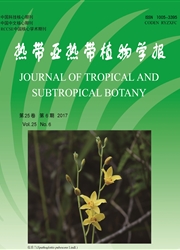

 中文摘要:
中文摘要:
为研究巴西橡胶树(Hevea brasiliensis)中HbSUT3和HbSUT5基因的功能,采用地高辛标记的RNA探针与橡胶树嫩茎和中脉两种组织切片分别进行RNA原位杂交,对这2种SUT基因在组织中的表达区域与表达特点进行了分析。结果表明,在橡胶树嫩茎中,两个SUT基因主要在树皮的韧皮部和皮层细胞中表达;在中脉中,两个SUT基因在除木质部导管系统外的其它部位均有表达;HbSUT3基因在嫩茎和中脉中的表达量相近,而HbSUT5基因在嫩茎中的表达量远高于中脉。这些揭示HbSUT3和HbSUT5基因可能广泛参与韧皮部装载、蔗糖运输与库细胞供给等活动,同时两个SUT基因也存在功能分化。
 英文摘要:
英文摘要:
In para rubber tree (Hevea brasiliensis), HbSUT3 plays the role of key sucrose transporter (SUT) in sucrose loading into laticifers and rubber productivity, whereas HbSUT5 is putatively involved in the regulation of sucrose loading into laticifers. To further investigate the functions of the two SUT genes, digoxigenin-labeled cRNA probes were prepared, and used by in situ hybridization to detect the distribution patterns of HbSUT3 and HbSUT5 mRNAs in tissues of rubber young stems and midribs. The results showed that the two SUT genes were mainly expressed in phloem and cortex of barks in young stems, whereas they were expressed in all tissues of midribs except for xylem. The expressions of HbSUT3 were similar between young stems and midribs, while the expression of HbSUT5 in young stems was much higher than that in midribs. It was suggested that HbSUT3 and HbSUT5 could involve in activities, such as phloem loading, sucrose transportation and supply to sink cells, and they also had functional differentiation.
 同期刊论文项目
同期刊论文项目
 同项目期刊论文
同项目期刊论文
 期刊信息
期刊信息
